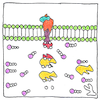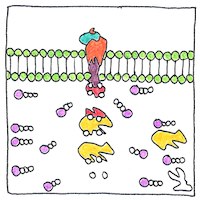Frederick Banting, Charles Herbert Best
medicine

|
Insulin
Claude Bernard’s methods paid off to help people with diabetes. Bernard advocated experimenting with animals. Experiments with dogs showed diabetes was a problem with the pancreas. Clusters of cells in the pancreas called “islets of Langerhans” secreted a hormone assumed to regulate sugar metabolism. But extracts from pancreas of healthy dogs proved to be unsuccessful therapies for dogs with diabetes. Frederick Banting assumed these attempts failed because liquids from other cells in the pancreas deactivated the secretions from the islets. Working with Charles Best, Banting tied off a dog’s pancreatic duct, which they knew would cause the pancreas to atrophe except for the islets. From these, they were able to extract a substance that restored the health of a diabetic dog.
Coin toss
Banting convinced J.J.R. Macleod to let him use his laboratory and eleven dogs at the University of Toronto to experiment with the pancreas. Macleod assigned two medical students, Clark Noble and Charles Best, as lab assistants, but Banting wanted only one assistant at a time. Best won the first turn by a coin toss and Noble was not given a chance to take his turn because Banting decided to keep Best for the entire summer.
Secretions
The pancreas has more than one kind of cell; it produces digestive enzymes that are needed in the small intestines, and its islet of Langerhans cells secrete hormones—glucagon, amulin, somatostatin, pancreatic polypeptide, ghrelin, and insulin—directly into the bloodstream. The insulin extracted from a dog’s atrophed pancreas cured a dog, but when given to a fourteen-year-old boy caused a severe allergic reaction. The rest of the history of insulin is about developing a pure source for the hormone to make it safe for humans. Today, insulin is made by genetically altered E. coli. Funny to think that insulin from a dog, insulin from fetal calves, synthetic insulin, or insulin from altered E. coli is still the same as the hormone that a healthy pancreas in any animal with a backbone secretes but that it was so hard for chemists to tune in this one clean pure life-saving hormone.



The classic symptom of diabetes, known for many centuries, was sugar in the urine. Insulin causes cells in the body to take up glucose from the blood. Banting was right; an enzyme of the pancreas destroys insulin. Working with John Macleod, Banting and Best developed a pure form of insulin that they first called isletin.
See also in The book of science:
Readings in wikipedia: